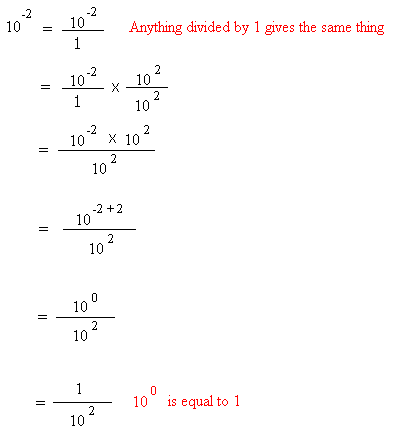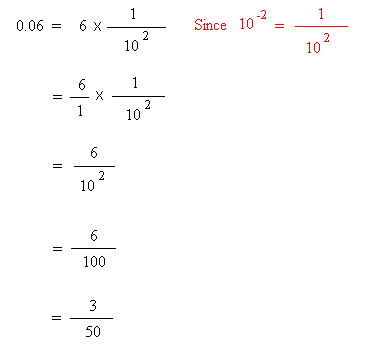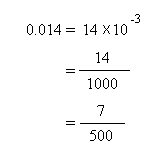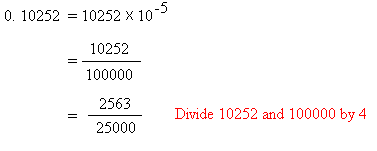When converting decimals to fractions, it may be beneficial to apply the technique used to convert a number to scientific notation. Review then the lesson about scientific notation before starting this lesson.
By all means, do not start this lesson before reviewing scientific notation because I am going to make use of scientific notation.Let’s start with an example. Convert 0.06 to a fraction.
0.06 = 6 × 10-2
Now, what is 10-2 equal to ?
Pay close attention to the following demonstration:

Why 100 = 1 ? Please keep reading to see the explanation in the end of this lesson.Since 0.06 = 6 × 10-2 , we get the following:

Example #2:
Convert 0.014 to a fraction.
Follow all the steps above again. First, convert 0.014 to scientific notation.
0.014 = 14 × 10-3
10-2 = 1 / 102, so 10-3 = 1 / 103
In general, 10-n = 1 / 10n
14 × 10-3 = 14 × 1 / 103
14 × 10-3 = (14 / 1) × (1 / 103)
14 × 10-3 = (14 × 1) / (1 × 103)
14 × 10-3 = 14 / 103
14 × 10-3 = 14 / 1000
Notice that you could have gotten to the result a little faster bu using the shortcut below. However, we wanted to show you first all the steps again so you understand deeply!

Example #3:
Convert 0.10252 to a fraction. First, convert 0.10252 to scientific notation.
0.10252 = 10252 × 10-5
10-5 = 1 / 105
10252 × 10-5 = 10252 × 1 / 105
10252 × 10-5 = (10252 / 1) × (1 / 105)
10252 × 10-5 = (10252 × 1) / (1 × 105)
10252 × 10-5 = 10252 / 105
10252 × 10-5 = 10252 / 1000
Once again, you could also just use the shortcut below:

Why 100 = 1?
In order to see why 100 is equal to 1, we need to make the following two important observations:
Observation #1: 10n / 10n = 1
Observation #2: 10n / 10n = 10n-n = 100
Therefore, 10n / 10n = 1 = 10n-n = 100
1 = 100
Leave a Reply